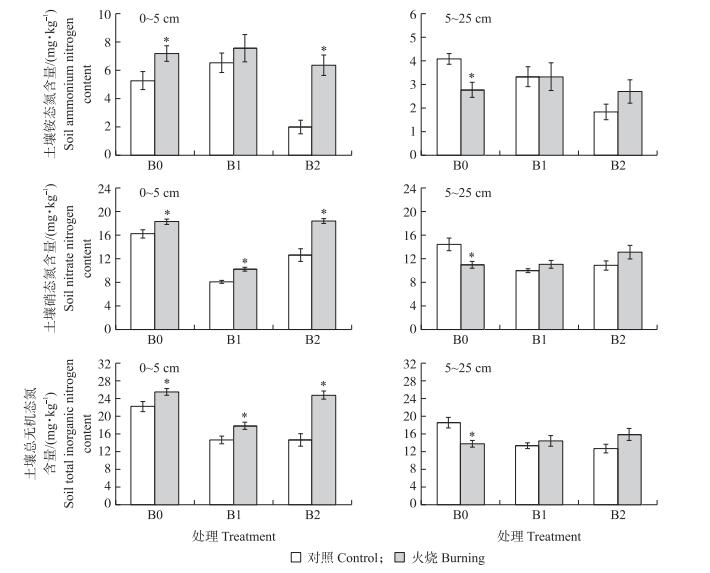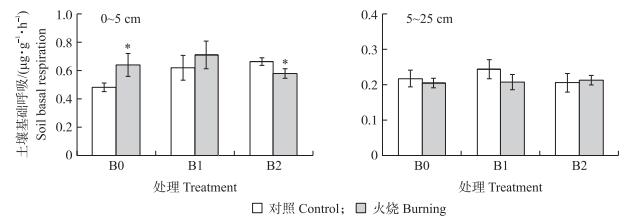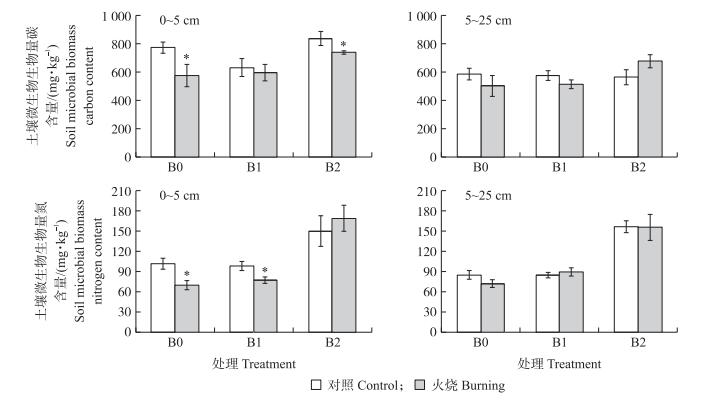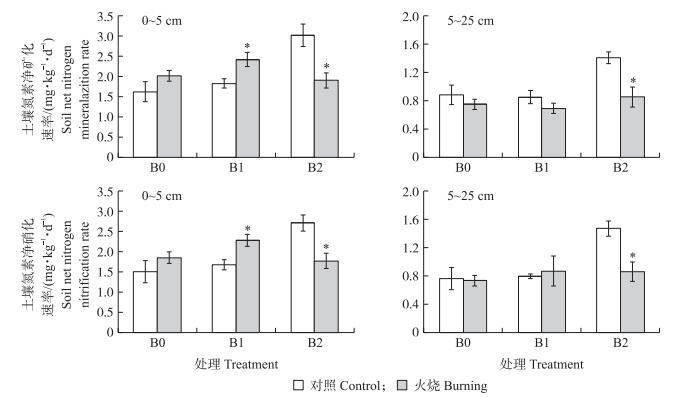文章信息
- 张琳, 王益, 舒梦, 张艺, 李真, 郭辉, 李春越, 胡水金
- ZHANG Lin, WANG Yi, SHU Meng, ZHANG Yi, LI Zhen, GUO Hui, LI Chunyue, HU Shuijin
- 火烧对黄土高原草地土壤氮素净矿化速率和净硝化速率的影响
- Effects of burning on soil net nitrogen mineralization rate and net nitrification rate in a semi-arid grassland on the Loess Plateau
- 南京农业大学学报, 2017, 40(6): 1051-1057
- Journal of Nanjing Agricultural University, 2017, 40(6): 1051-1057.
- http://dx.doi.org/10.7685/jnau.201701026
-
文章历史
- 收稿日期: 2017-01-12
2. 中国科学院地球环境研究所 黄土与第四纪地质国家重点实验室, 陕西 西安 710061;
3. 陕西师范大学旅游与环境学院, 陕西 西安 710119;
4. 北卡罗来纳州立大学昆虫和植物病理学系, 美国 北卡 27695
2. State Key Laboratory of Loess and Quaternary, Institute of Earth Environment, Chinese Academy of Sciences, Xi'an 710061, China;
3. College of Tourism and Environment Sciences, Shaanxi Normal University, Xi'an 710119, China;
4. Department of Entomology and Plant Pathology, North Carolina State University, Raleigh, NC 27695, USA
黄土高原是世界上最大的黄土集中区, 总面积为62万km2, 其中草地约占黄土高原面积的30%[1]。由于受气候变化和人类生产活动的影响, 该地区出现草地退化和水土流失等一系列生态环境问题, 致使黄土高原成为我国典型的生态脆弱地带和全球变化敏感区[2]。封育作为该地区退化草地生态系统植被恢复的有效措施, 在草地资源保护和提升方面发挥着重要作用。随着恢复年限增加, 凋落物大量积累, 草地生态系统出现生产力下降, 物种多样性不再增加甚至降低的现象[3]。作为草原生态系统最主要的干扰因子之一, 火烧对生态系统具有强大的调节能力。火烧不仅对地上植物群落结构、多样性和生产力产生重要影响[4], 还会改变土壤理化性质[5]以及土壤微生物群落结构和活性[6], 最终影响草原生态系统的结构和功能[7]。
氮是植物生长发育和代谢活动的必需营养元素, 在生态系统养分循环过程中起着重要的作用[8]。土壤氮素矿化是土壤中有机态氮在微生物作用下转化为无机态氮的过程, 决定着土壤氮素的可利用性, 是生态系统氮循环的重要环节[9]。影响氮矿化过程的因素不仅包括土壤动物和微生物等生物因素, 还包括非生物因素(如土壤pH值、深度、温度、湿度、凋落物状况以及火烧、施肥等人为干扰)[10-12]。大量的研究表明, 火烧对不同草原生态系统土壤氮素可利用性的影响是不同的[13-15]。
目前, 已有学者对黄土高原典型草地的火烧干扰进行了研究, 但这些研究主要集中在地上植被组成和结构变化[16]以及土壤理化性质方面[5], 而火烧对土壤养分循环, 尤其是对氮素矿化过程的影响研究还相对较少。因此, 本文选取位于黄土高原的宁夏云雾山国家级自然保护区已封育34年的典型草地为研究对象, 研究不同火烧恢复年限对草地土壤氮素净矿化速率和净硝化速率的影响, 揭示其潜在的影响机制, 为恢复草地生态系统的适应性管理提供理论依据。
1 材料与方法 1.1 试验地概况研究样地位于宁夏回族自治区固原市东北部的云雾山国家级自然保护区(36°15′N, 106°23′E)。该区属中温带半干旱气候区, 土壤为黄土母质上发育的淡黑垆土和黄绵土, 海拔1 800~2 100 m, 年平均气温5.0 ℃, 年降雨量400~450 mm, 干燥度为1.5~2.0, 蒸发量为1 330~1 640 mm, 无霜期为112~140 d。保护区内植物的主要类型有本氏针茅(Stipa bungeana)、大针茅(Stipa grandis)、铁杆蒿(Artemisia sacrorum)和百里香(Thymus mongolicus)[17]。
1.2 取样方法采用配对取样的方法, 于2015年6月分别采集新烧地(B0)、火烧后1年(B1)和火烧后2年(B2)的对照和火烧土壤样品(共6个处理), 每个处理设置5个采样点。每个采样点用直径为5 cm的土钻取4钻土壤样品混合为1个样本, 并采集2个深度:0~5 cm和5~25 cm。3块火烧迹地相距1.5~2.0 km。将采集好的新鲜土壤样品标记分类后立即带回实验室。土壤样品过2 mm筛后, 一部分用于土壤基本理化性质的测定; 另一部分置于4 ℃冰箱, 用于微生物生物量碳和氮含量的测定及室内培养试验。
1.3 土壤理化性质测定土壤理化指标均参照文献[18]测定。采用烘干法测定土壤含水量; 采用pH计测定(水土质量比为2.5:1)土壤pH值; 采用元素分析仪(Elementar vario MACRO cube, Germany)测定土壤总碳(total carbon, TC)、总氮(total nitrogen, TN)含量; 采用硫酸钾溶液浸提-流动分析仪测定土壤铵态氮(NH4+-N)和硝态氮(NO3--N)含量。测定结果均以干土质量计。
1.4 土壤生物学性质测定采用氯仿熏蒸-硫酸钾浸提法测定土壤微生物生物量碳和氮(microbial biomass carbon and nitrogen, MBC and MBN)[19-20]。采用气相色谱法测定土壤基础呼吸。
1.5 土壤氮素净矿化速率和净硝化速率测定称取20 g鲜土装入150 mL呼吸瓶, 土壤含水量调至田间持水量的60%, 随后将呼吸瓶置于25 ℃恒温培养箱中进行黑暗培养, 并设置空白对照, 定期进行通气和调节含水量, 共培养30 d。土壤硝化速率和氨化速率是通过培养前、后土壤NO3--N和NH4+-N含量的差值来计算。氮素净矿化速率和净硝化速率分别为单位时间内无机态氮(包括NO3--N和NH4+-N)含量和NO3--N含量变化。具体计算公式如下:

|
(1) |

|
(2) |

|
(3) |

|
(4) |

|
(5) |

|
(6) |
式中:t1为培养开始日期; t2为培养结束日期; Δt为培养时间; c(NO3--N)1和c(NO3--N)2分别为培养前、后土壤样品中硝态氮浓度; c(NH4+-N)1和c(NH4+-N)2分别为培养前、后土壤样品中铵态氮浓度; Anit、Aamn和Amin分别为硝态氮、铵态氮和总无机态氮的净积累量; Rnit和Rmin分别为氮素净硝化速率和净矿化速率。土壤氮素净矿化速率和净硝化速率的单位均换算为单位风干土质量。
1.6 数据处理分析利用Statistic 7.0软件进行数据分析, 并采用Origin Pro 9.0作图。
2 结果与分析 2.1 火烧对土壤基本性质的影响由表 1可知:0~5 cm土层除新烧地pH值与对照相比有显著差异外, 火烧后1年及火烧后2年无显著差异。在0~25 cm土层, 与对照相比, 新烧地土壤含水量显著降低, 但这种降低是暂时的, 火烧后1年和火烧后2年土壤含水量与对照差异不显著(P>0.05);新烧地土壤总氮含量也显著低于对照, 而且火烧后1年和火烧后2年0~5 cm土层总氮含量也显著低于对照(P < 0.05)。另外, 火烧均使土壤碳氮比增加, 总碳含量降低。
| 指标 Index | 新烧地(B0)New burning | 火烧后1年(B1)One year after burning | 火烧后2年(B2)Two years after burning | |||||
| 对照Control | 火烧Burning | 对照Control | 火烧Burning | 对照Control | 火烧Burning | |||
| 0~5 cm | ||||||||
| pH值pH value | 7.34±0.02b | 7.44±0.02a | 7.31±0.02a | 7.35±0.01a | 7.29±0.03a | 7.26±0.02a | ||
| 含水量/% Soil moisture | 19.80±0.02a | 7.63±0.01b | 7.75±0.78a | 6.63±0.43a | 18.97±1.35a | 16.62±0.67a | ||
| 总碳含量/(g·kg-1)Total carbon content | 48.08±0.97a | 45.20±1.73a | 46.32±0.93a | 44.52±0.56a | 51.16±0.43a | 50.10±1.06a | ||
| 总氮含量/(g·kg-1)Total nitrogen content | 3.72±0.09a | 3.38±0.04b | 3.66±0.09a | 3.24±0.07b | 4.28±0.05a | 4.08±0.07b | ||
| 碳氮比C/N | 12.94±0.32a | 13.38±0.07a | 12.67±0.20b | 13.75±0.18a | 11.95±0.17a | 12.28±0.13a | ||
| 5~25 cm | ||||||||
| pH值pH value | 7.56±0.04a | 7.59±0.02a | 7.41±0.01a | 7.43±0.01a | 7.54±0.05a | 7.57±0.03a | ||
| 含水量/% Soil moisture | 20.42±1.43a | 12.49±0.52b | 13.02±0.75a | 11.25±0.43a | 19.71±0.02a | 19.94±0.01a | ||
| 总碳含量/(g·kg-1)Total carbon content | 41.32±0.66a | 39.20±0.77a | 41.56±0.40a | 40.42±0.28a | 41.14±1.38a | 38.90±0.50a | ||
| 总氮含量/(g·kg-1)Total nitrogen content | 3.14±0.11a | 2.94±0.10b | 3.12±0.05a | 2.92±0.11a | 3.62±0.10a | 3.36±0.06a | ||
| 碳氮比C/N | 13.20±0.28a | 13.37±0.30a | 13.33±0.10a | 13.90±0.42a | 11.36±0.10a | 11.58±0.15a | ||
| 注:相邻两列不同小写字母代表处理间差异显著(P < 0.05)。 Note:Different lower case letters within the adjacent two columns indicate significant differences between treatments at 0.05 level. | ||||||||
由图 1可知:在0~5 cm土层, 新烧地和火烧后2年显著提高了土壤铵态氮、硝态氮和总无机态氮含量, 火烧后1年显著提高了硝态氮和总无机态氮含量(P < 0.05)。对于5~25 cm土层, 除新烧地土壤铵态氮、硝态氮和总无机态氮含量均显著低于对照外, 火烧后1年和火烧后2年与对照相比有增加趋势, 但未达到显著水平(P>0.05)。

|
图 1 不同火烧恢复年限和深度土壤铵态氮、硝态氮和总无机态氮含量的变化 Figure 1 Changes of soil ammonium nitrogen, nitrate nitrogen and total inorganic nitrogen content at different depths in different burning years B0为新烧地; B1为火烧后1年; B2为火烧后2年。*代表处理间在0.05水平上差异显著。下同。 B0 means new burning; B1 means one year after burning; B2 means two years after burning.*indicates significant difference between treatments at 0.05 level. The same as follows. |
土壤的基础呼吸随土壤深度增加而逐渐降低(图 2)。与对照相比, 火烧后0~5 cm土层土壤基础呼吸呈现先增加后减少的趋势, 除火烧后1年外, 新烧地和火烧后2年均达到显著水平(P < 0.05)。在5~25 cm土层, 不同火烧恢复年限土壤基础呼吸与对照相比差异不显著(P>0.05)。

|
图 2 不同火烧恢复年限和深度土壤基础呼吸的变化 Figure 2 Changes of soil basal respiration at different depths in different burning years |
不同火烧恢复年限对不同深度土壤微生物生物量碳和氮含量的影响有差异(图 3)。0~5 cm土层火烧使土壤微生物生物量碳含量降低, 但新烧地和火烧后2年达到显著水平; 新烧地和火烧后1年土壤微生物生物氮含量显著降低(P < 0.05), 但火烧后2年有增加的趋势。对于5~25 cm土层, 不同火烧恢复年限土壤微生物生物量碳和氮含量与对照差异不显著(P>0.05)。

|
图 3 不同火烧恢复年限和土层土壤微生物生物量碳和氮含量的变化 Figure 3 Changes of soil microbial biomass carbon and nitrogen at different depths in different burning years |
由图 4可知:与对照相比, 0~5 cm土层土壤氮素净矿化速率和净硝化速率在不同火烧恢复年限变化不同。其中, 新烧地土壤氮素净矿化速率和净硝化速率有增加的趋势, 但差异不显著; 火烧后1年分别显著增加32.46%和36.30%, 火烧后2年分别显著降低了36.87%和34.70%。5~25 cm土层, 与对照相比, 火烧后2年土壤氮素净矿化速率和净硝化速率分别显著降低了36.87%和34.70%, 新烧地和火烧后1年均没有发生显著改变(P>0.05)。

|
图 4 不同火烧恢复年限不同深度土壤氮素净矿化速率和净硝化速率的变化 Figure 4 Changes of soil net nitrogen mineralization rate and nitrification rate at different depths after different burning years |
火烧打破了大气、植被、地表凋落物和土壤之间的水热平衡, 对生态系统的结构与功能影响深远[21]。本研究中, 火烧使土壤含水量降低, 这与李玉中等[22]在吉林省羊草草原自然保护区的研究结果相同, 主要原因如下:1)火烧使地面裸露, 土壤温度升高, 增加了水分的蒸发; 2)火烧后土壤渗透性的下降, 土壤疏水层的形成会阻止水分向土壤中渗透。与对照相比, 火烧后释放大量的碱性离子使土壤pH值呈升高趋势, 但只有在新烧地0~5 cm土层才达到显著水平。这与姚余君等[23]在森林中的研究结果一致, 可能是由于火烧后地表的枯枝落叶等转化为土壤灰分并随雨水下渗到土壤中, 造成pH值升高。
由于火烧强度、土地类型和火烧时的气候条件不同, 目前火烧对土壤有机质含量的影响研究还没有得出统一的结论[24]。在本研究中, 火烧降低了土壤有机质含量, 可能的原因除了因为火烧使土壤表层枯枝落叶层损失, 减少表层土壤的有机质含量, 还可能是由于火烧后土壤温度升高, 刺激土壤微生物活性, 从而导致土壤呼吸增强, 造成草原生态系统的碳大量损失[25-26]。火烧使得地表温度升高, 加速了氮的矿化, 增加了土壤铵态氮、硝态氮和无机养分的含量, 降低了有机氮含量, 而土壤有机氮占土壤含量的95%, 最终导致火烧土壤全氮含量降低。另外, 氮在火烧时极易挥发, 导致土壤总氮含量降低, 王丽等[27]对山地林火烧迹地土壤养分的动态变化研究也证明了这一观点。
3.2 火烧对土壤微生物的影响土壤微生物是陆地生态系统中最活跃的组分, 在物质循环和能量流动中起着重要作用。微生物生物量及其呼吸速率是衡量土壤微生物活性的重要指标[28-29]。本研究发现, 土壤表层的微生物生物量在火烧干扰后降低, 这可能是由于火烧的热解作用及其对草地有机质的消耗所致[30]。土壤基础呼吸随着火烧恢复年限的增加呈现先升高后降低的趋势, 这可能是由于火烧过程中土壤释放出大量碱性离子, 提高了土壤pH值。偏碱性的环境和地表温度的升高均有利于微生物活性, 使微生物呼吸增强, 有机碳被大量分解, 产生更多的CO2[26]。随火烧恢复年限的增加, 微生物活性减弱, 土壤总碳和总氮含量减少, 导致CO2释放量减少。
3.3 火烧对土壤氮素净矿化速率和净硝化速率的影响火烧对土壤氮素转化过程的影响程度, 因火烧时间、火烧程度而有所不同。本研究中, 0~5 cm土层, 与对照相比, 火烧后1年显著增加了土壤氮素净矿化速率和净硝化速率, 火烧后2年则表现出相反的趋势。出现这种现象的主要原因可能有:1)火烧引起的地表温度和pH值的升高在一定范围内使硝化细菌的活性增强[22]; 2)火烧后K+等大量离子释放出来, 促进了氮的矿化、硝化作用[31]; 3)火烧使土壤总氮和微生物量减少, 均在一定程度上减弱了土壤的可矿化氮效率, 从而使土壤氮素净矿化速率和净硝化速率降低。土壤的氮矿化过程除受非生物因子影响外, 还受凋落物质量、土壤动物、植被类型和恢复情况[18]以及其他自然因素的影响, 而且这些因素在不同强度下也存在较大差异, 对矿化过程的影响非常复杂。
综上所述, 通过对不同火烧恢复年限土壤氮矿化的研究, 我们发现火烧能使土壤环境发生短期变化, 这种变化加速了土壤氮矿化过程, 提高了土壤中植物-微生物可利用态氮含量, 从而对草原生态系统的植物生长起到一定的促进作用。因此, 该研究为黄土高原半干旱区典型草地植被生产力的提高和植物多样性的维持提供理论依据。
宁夏回族自治区云雾山国家级自然保护区管理局在样品采集过程中给予了支持和帮助, 谨致谢意。
| [1] | Liu Z P, Shao M A, Wang Y Q. Effect of environmental factors on regional soil organic carbon stocks across the Loess Plateau region, China[J]. Agriculture, Ecosystems and Environment, 2011, 142(3): 184–194. |
| [2] |
程积民.
中国黄土高原植被建设与水土保持[M]. 北京: 中国林业出版社, 2002.
Cheng J M. The Chinese Loess Plateau Vegetation Construction and Soil and Water Conservation[M]. Beijing: China Forestry Publishing, 2002. (in Chinese with English abstract) |
| [3] | Cheng J, Cheng J M, Hu T M, et al. Dynamic changes of Stipa bungeana steppe species diversity as better indicators for soil quality and sustainable utilization mode in Yunwu Mountain Nature Reserve, Ningxia, China[J]. Clean Soil Air Water, 2012, 40(2): 127–133. DOI: 10.1002/clen.v40.2 |
| [4] | Wang C H, Han X G, Xing X R. Effects of grazing exclusion on soil net nitrogen mineralization and nitrogen availability in a temperate steppe in northern China[J]. Journal of Arid Environments, 2010, 74(10): 1287–1293. DOI: 10.1016/j.jaridenv.2010.05.024 |
| [5] |
李媛, 程积民, 魏琳, 等. 云雾山典型草原火烧不同恢复年限土壤化学性质变化[J].
生态学报, 2013, 33(7): 2131–2138.
Li Y, Cheng J M, Wei L, et al. Changes of soil chemical properties after different burning years in typical steppe of Yunwu Mountains[J]. Acta Ecologica Sinica, 2013, 33(7): 2131–2138. (in Chinese with English abstract) |
| [6] |
赵先丽, 程海涛, 吕国红, 等. 土壤微生物生物量研究进展[J].
气象与环境学报, 2006, 22(4): 68–72.
Zhao X L, Cheng H T, Lü G H, et al. Advances in soil microbial biomass[J]. Journal of Meteorology and Environment, 2006, 22(4): 68–72. (in Chinese with English abstract) |
| [7] |
程杰, 呼天明, 程积民. 黄土高原半干旱区云雾山封禁草原30年植被恢复对气候变化的响应[J].
生态学报, 2010, 30(10): 2630–2638.
Cheng J, Hu T M, Cheng J M. Responses of vegetation restoration to climate change during the past 30 years in enclosed grassland of Yunwu Mountain in semi-arid region of the Loess Plateau[J]. Acta Ecologica Sinica, 2010, 30(10): 2630–2638. (in Chinese with English abstract) |
| [8] | Lupi C, Morin H, Deslauriers A, et al. Role of soil nitrogen for the conifers of the boreal forest:a critical review[J]. International Journal of Plant and Soil Science, 2013, 2: 155–189. DOI: 10.9734/IJPSS |
| [9] | Abera G, Wolde-Meskel E, Bakken L R. Carbon and nitrogen mineralization dynamics in different soils of the tropics amended with legume residues and contrasting soil moisture contents[J]. Biology and Fertility of Soils, 2012, 48(1): 51–66. DOI: 10.1007/s00374-011-0607-8 |
| [10] |
王常慧, 邢雪荣, 韩兴国. 草地生态系统中土壤氮素矿化影响因素的研究进展[J].
应用生态学报, 2004, 15(11): 2184–2188.
Wang C H, Xing X R, Han X G. Advances in study of factors affecting soil N mineralization in grassland ecosystems[J]. Chinese Journal of Applied Ecology, 2004, 15(11): 2184–2188. DOI: 10.3321/j.issn:1001-9332.2004.11.040 (in Chinese with English abstract) |
| [11] |
王艳杰, 邹国元, 付桦, 等. 土壤氮素矿化研究进展[J].
中国农学通报, 2005, 21(10): 203–208.
Wang Y J, Zou G Y, Fu H, et al. Development and advance of soil nitrogen mineralization[J]. Chinese Agricultural Science Bulletin, 2005, 21(10): 203–208. DOI: 10.3969/j.issn.1000-6850.2005.10.056 (in Chinese with English abstract) |
| [12] |
李贵才, 韩兴国, 黄建辉, 等. 森林生态系统土壤氮矿化影响因素研究进展[J].
生态学报, 2001, 21(7): 1187–1195.
Li G C, Han X G, Huang J H, et al. A review of affecting factors of soil nitrogen mineralization in forest ecosystems[J]. Acta Ecologica Sinica, 2001, 21(7): 1187–1195. (in Chinese with English abstract) |
| [13] | Yahdjian L, Sala O E. Do litter decomposition and nitrogen mineralization show the same trend in the response to dry and wet years in the Patagonian steppe?[J]. Journal of Arid Environments, 2008, 72(5): 687–695. DOI: 10.1016/j.jaridenv.2007.09.005 |
| [14] | Li Y Z, Herbert S J. Influence of prescribed burning on nitrogen mineralization and nitrification in grassland[J]. Communications in Soil Science and Plant Analysis, 2004, 35(3/4): 571–581. |
| [15] | Wan S Q, Hui D F, Luo Y Q. Fire effects on nitrogen pools and dynamics in terrestrial ecosystems:a meta-analysis[J]. Ecological Applications, 2001, 11(5): 1349–1365. DOI: 10.1890/1051-0761(2001)011[1349:FEONPA]2.0.CO;2 |
| [16] | Wu G L, Zhao L P, Wang D, et al. Effects of time-since-fire on vegetation composition and structures in semi-arid perennial grassland on the Loess Plateau, China[J]. Clean Soil Air Water, 2014, 42(1): 98–103. DOI: 10.1002/clen.v42.1 |
| [17] |
宁夏云雾山草原自然保护区管理处.
宁夏云雾山自然保护区科学考察与管理文集[M]. 银川: 宁夏人民出版社, 2001.
The Management Office of Grassland Natural Reservation in Ningxia Yunwu Mountains. A Collected Works on Scientific Investigation and Management in Ningxia Yunwu Reservation[M]. Yinchuan: Ningxia People Press, 2001. (in Chinese with English abstract) |
| [18] |
鲍士旦.
土壤农化分析[M]. 3版. 北京: 中国农业出版社, 2000.
Bao S D. Soil Agrochemical Analysis[M]. 3rd ed. Beijing: China Agriculture Press, 2000. (in Chinese with English abstract) |
| [19] | Vance E D, Brookes P C, Jenkinson D S. An extraction method for measuring soil microbial biomass C[J]. Soil Biology and Biochemistry, 1987, 19(6): 703–707. DOI: 10.1016/0038-0717(87)90052-6 |
| [20] | Brookes P C, Landman A, Pruden G, et al. Chloroform fumigation and the release of soil nitrogen:a rapid direct extraction method to measure microbial biomass nitrogen in soil[J]. Soil Biology and Biochemistry, 1985, 17(6): 837–842. DOI: 10.1016/0038-0717(85)90144-0 |
| [21] |
王艳霞, 杨桂英, 张政. 火干扰对森林土壤理化性质的影响[J].
防护林科技, 2012(4): 1–3.
Wang Y X, Yang G Y, Zhang Z. Effects of fire disturbance on soil physical and chemical properties of forest[J]. Protection Forest Science and Technology, 2012(4): 1–3. (in Chinese with English abstract) |
| [22] |
李玉中, 祝廷成, 李建东, 等. 火烧对草地土壤氮总矿化、硝化及无机氮消耗速率的影响[J].
应用生态学报, 2003, 14(2): 223–226.
Li Y Z, Zhu T C, Li J D, et al. Effect of prescribed burning on grassland nitrogen gross mineralization and nitrification[J]. Chinese Journal of Applied Ecology, 2003, 14(2): 223–226. (in Chinese with English abstract) |
| [23] |
姚余君, 刘菲, 胡海清, 等. 火烧对胡桃楸人工林土壤化学性质的影响[J].
东北林业大学学报, 2008, 36(7): 34–36.
Yao Y J, Liu F, Hu H Q, et al. Effect of fire on soil properties of manchurian walnut plantation[J]. Journal of Northeast Forestry University, 2008, 36(7): 34–36. (in Chinese with English abstract) |
| [24] | González P J A, González V F J, Almendrosb G, et al. The effect of fire on soil organic matter:a review[J]. Environment International, 2004, 30(6): 855–870. DOI: 10.1016/j.envint.2004.02.003 |
| [25] |
郭剑芬, 杨玉盛, 陈光水, 等. 火烧对森林土壤有机碳的影响研究进展[J].
生态学报, 2015, 35(9): 2800–2809.
Guo J F, Yang Y S, Chen G S, et al. A review of effects of fire on soil organic carbon in forests[J]. Acta Ecologica Sinica, 2015, 35(9): 2800–2809. (in Chinese with English abstract) |
| [26] |
穆蓁, 张艳艳, 戎郁萍. 火烧和刈割耙除对羊草+大针茅草原土壤性状的影响[J].
中国草地学报, 2014(5): 101–106.
Mu Z, Zhang Y Y, Rong Y P. Effects of burning and raking on soil properties in Leymus chinensis+Stipa grandis steppe[J]. Chinese Journal of Grassland, 2014(5): 101–106. (in Chinese with English abstract) |
| [27] |
王丽, 嵨一徹. 山地林火烧迹地土壤养分的动态变化[J].
水土保持通报, 2008, 28(1): 81–85.
Wang L, Kazuto S. Research on the dynamic change of soil nutrients in the burned area of mountain forest[J]. Bulletin of Soil and Water Conservation, 2008, 28(1): 81–85. (in Chinese with English abstract) |
| [28] |
何亚婷, 董云社, 齐玉春, 等. 草地生态系统土壤微生物量及其影响因子研究进展[J].
地理科学进展, 2010, 29(11): 1350–1359.
He Y T, Dong Y S, Qi Y C, et al. Advances in researches on soil microbial biomass of grassland ecosystems and its influencing factors[J]. Progress in Geography, 2010, 29(11): 1350–1359. DOI: 10.11820/dlkxjz.2010.11.020 (in Chinese with English abstract) |
| [29] |
贾丙瑞, 周广胜, 王凤玉, 等. 土壤微生物与根系呼吸作用影响因子分析[J].
应用生态学报, 2005, 16(8): 1547–1552.
Jia B R, Zhou G S, Wang F Y, et al. Affecting factors of soil microorganism and root respiration[J]. Chinese Journal of Applied Ecology, 2005, 16(8): 1547–1552. (in Chinese with English abstract) |
| [30] |
陶玉柱, 邸雪颖. 火对森林土壤微生物群落的干扰作用及其机制研究进展[J].
林业科学, 2013, 49(11): 146–157.
Tao Y Z, Di X Y. Fire interference on forest soil microbial communities and the mechanism:a review[J]. Scientia Silvae Sinicae, 2013, 49(11): 146–157. (in Chinese with English abstract) |
| [31] | Campino I. Effect of the K fertilization on the N-mineralization in a grassland soil and on the N-uptake by Italian ryegrass[C]//Proceedings of the ⅩⅤ International Grassland Congress. 1985:452-453. |




